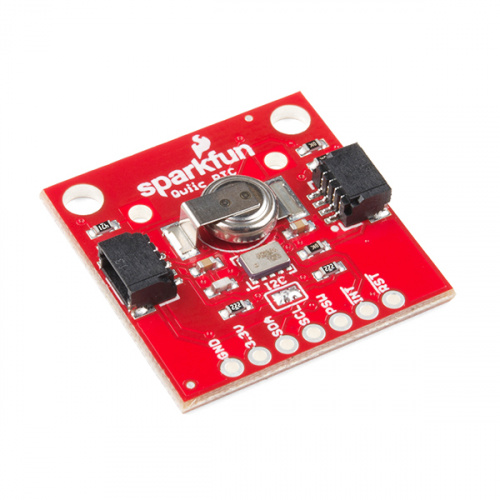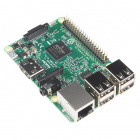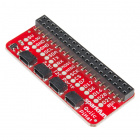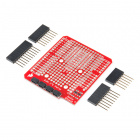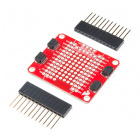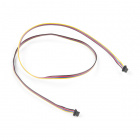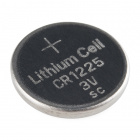Favorited
Favorite
2
Introduction
The Qwiic Real Time Clock (RTC) module is a Qwiic-enabled breakout board for the RV-1805 module! The RTC is ultra-low power (running at about 22 nA in its lowest power setting) so it can use a supercapacitor for backup power instead of a normal battery. This means infinite charge and discharge cycles without any degradation to the "battery" (in this case, a supercapacitor). The breakout board is also a part of SparkFun's Qwiic system, so you won't have to do any soldering to figure out what time it is.
In stock
BOB-14558
This SparkFun Real Time Clock (RTC) Module is a Qwiic-enabled breakout board for the RV-1805 chipset running at only about 22…
4
In this hookup guide, we'll take advantage of the Arduino IDE to automatically set the time of the RTC to the compiler time. Once we have the time set, we'll set the alarm to a time of our choice and have it generate a signal on the interrupt pin. We'll also look at how charged the RTC is so we know when to unplug the RTC from power (when it's full of course). Finally, we'll look at how to store other data into the RTC so we can keep important variables safe when our system loses power. We'll also go over how to extend the battery life of your RTC by adding an external battery.
Required Materials
To get started, you'll need a microcontroller to control everything in your project.
In stock
DEV-13975
The SparkFun RedBoard combines the simplicity of the UNO's Optiboot bootloader, the stability of the FTDI, and the shield com…
49
In stock
DEV-13907
The SparkFun ESP32 Thing is a comprehensive development platform for Espressif’s ESP32, their super-charged version of the …
69
Retired
WRL-13774
Particle's IoT (Internet of Things) hardware development board, the Photon, provides everything you need to build a connected…
32
Retired
Retired
DEV-13825
Everyone knows and loves Raspberry Pi, but what if you didn't need additional peripherals to make it wireless. The Raspberry …
92
Retired
Now to get your microcontroller into the Qwiic ecosystem, the key will be one of the following Qwiic shields to match your preference of microcontroller:
In stock
DEV-14459
The SparkFun Qwiic HAT for Raspberry Pi is the quickest and easiest way to make your way into the Qwiic ecosystem and still u…
5
In stock
DEV-14352
The SparkFun Qwiic Shield is an easy-to-assemble board that provides a simple way to incorporate the Qwiic Connect System wit…
9
Retired
DEV-14477
The SparkFun Qwiic Shield for Photon is an easy-to-assemble board that provides a simple way to incorporate the Qwiic System …
Retired
You will also need a Qwiic cable to connect the shield to your RTC, choose a length that suits your needs.
In stock
PRT-14426
This is a 50mm long 4-conductor cable with 1mm JST termination. It’s designed to connect Qwiic enabled components together …
In stock
PRT-14427
This is a 100mm long 4-conductor cable with 1mm JST termination. It’s designed to connect Qwiic enabled components together…
Retired
PRT-14429
This is a 500mm long 4-conductor cable with 1mm JST termination. It’s designed to connect Qwiic enabled components together…
1
Retired
Retired
PRT-14428
This is a 200mm long 4-conductor cable with 1mm JST termination. It’s designed to connect Qwiic enabled components together…
Retired
Finally, if your application requires that your RTC be without power for over a month, we'd recommend using the optional battery and battery holder to extend the time that the RTC will remain active without power.
In stock
PRT-00337
CR1225 lithium metal 3V 12mm 47mAh coin cell batteries. Perfect small battery for miniature sensor node applications.
Thes…
2
Out of stock
PRT-07948
This is a through-hole 12mm coin cell battery holder. It's the unit we like to use as RTC backup and SRAM backup for GPS unit…
Suggested Reading
If you aren't familiar with the Qwiic system, we recommend reading here for an overview.
We would also recommend taking a look at the hookup guide for the Qwiic Shield if you haven't already. Brushing up on your skills in I2C is also recommended, as all Qwiic sensors are I2C.
I2C
An introduction to I2C, one of the main embedded communications protocols in use today.

